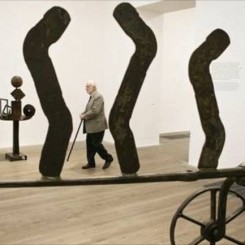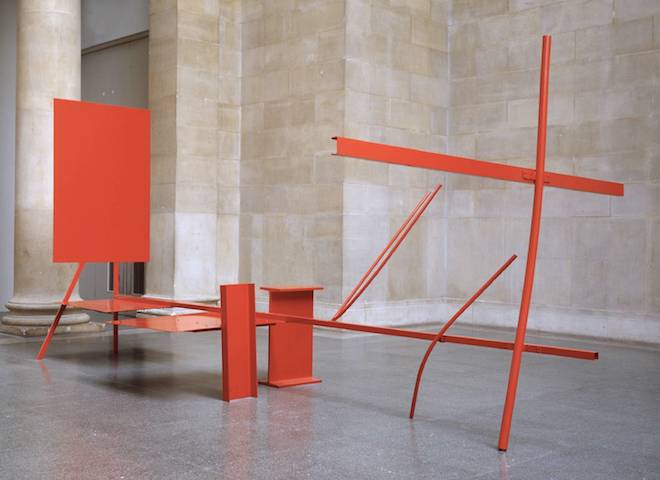Sir Anthony Caro, one of the 20th century’s most celebrated sculptors, has died at the age of 89.
His legacy will loom large over sculptors for generations to come. Caro was a major innovator and the leader of a broad collection of assemblage sculptors, who broke away from the traditions of the chisel and mallet to weld metal forms which stood on the floor, without the use of a pedestal. His innovations allowed the viewer to interact with the forms and spaces generated by the sculptures, and laid the foundations for huge and almost immediate change within sculpture and then across wider fields of three dimensional art.
Caro was influenced by a trip to the United States in 1959 where he met the American Surrealist sculptor David Smith, whose use of welded steel was to have a long-lasting affect. He also visited the studios of many of the New York school and listened closely to their ideas. Upon returning to the UK he found himself absorbed in a studio practice which focused almost entirely on metal assemblages. Starting from the 1960s Caro’s works utilized steel beams, railway track, and other pre-formed industrial sections. These were bolted and welded together before being painted.
Caro’s career took off as the result of a solo exhibition at the Whitechapel Gallery in London in 1963. The exhibition featured monochrome steel sculptures which had been painted all over with bright high gloss household paint. The reactions were instant and overwhelmingly positive. Of the 1962 work “Early One Morning”, Caro has said that he wanted the form to “be like a dance”, later saying that he aimed for his sculptures “[t]o talk to you like music.” With its long and sinuous steel bars and sheets he achieved both aims. The critics embraced Caro, describing his works as “visual poetry.” The mood experienced by encountering these works changes constantly as the viewer walks around them. It is no small achievement for a sculptor who had been convinced only a couple of years previously that his work would always remain figurative.
In 1967, the Rijksmuseum in Holland acknowledged Caro’s importance with a retrospective exhibition, only a few years after the same accolade was given to Lucio Fontana. In 1969 the Haywood Gallery in London also mounted a retrospective exhibition; the Museum of Modern Art followed suit in 1975 and the Serpentine Gallery in 1984, on the occasion of his 60th birthday. A flow of exhibitions carried Caro and his wife, the artist Sheila Girling, around the world, from Australia to the United States.
Exploring the merging of architecture and sculpture, in the 1990s Caro produced many monumental works which encouraged viewers to explore through cavities and ramps. They were amongst his most ambitious works by scale, peaking with his vast “Goodwood Steps.” He felt that sculpture “could be anything,” which many younger artists took to heart, liberated to experiment in the way Caro had himself sought decades before.
In the 1980s Caro’s works shifted towards the figurative, including a group of works affected by his interest in ancient Greece. This new trend resurfaced a few times in the following decades, with figure heads appearing as late as 2008. In 2004, to honor his 80th birthday, seven art galleries and museums, including the C. Grimaldis Gallery in Baltimore, Artemis Greenberg van Doren, Garth Clark Gallery in New York and Mitchell-Innes & Nash New York, Galerie Josine Bokhoven in Amsterdam, Galerie Daniel Templon in Paris and the Tate Britain all held exhibitions of his work.
In one of his last large-scale projects, Caro devised an immense sculpture which would extend over three city blocks down Park Avenue in Manhattan. After working on the sculptures at great length the project was shelved due to the cost. Caro responded by separating the works into 10 individual pieces which were shown at Gagosian Gallery in 2012, and might be considered amongst his most significant works.
Anthony Caro was honored in the UK with a CBE in 1969, a knighthood in 1987 and the Order of Merit in 2000. He and his with Sheila have two sons, Timothy and Paul.
Sir Anthony Caro, OM, RA, born March the 8th 1924, died October the 23rd 2013.




